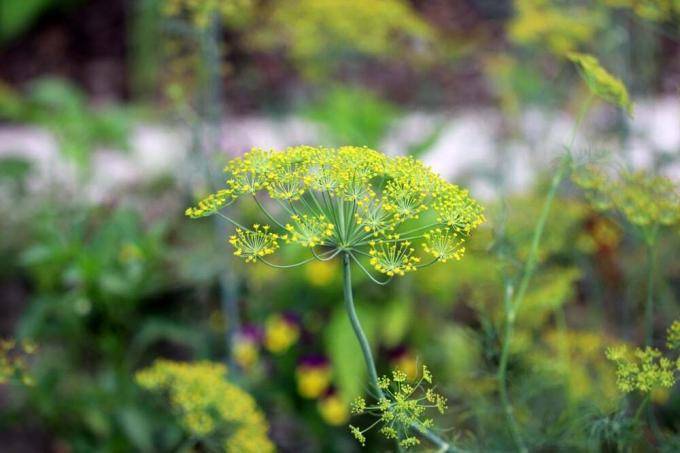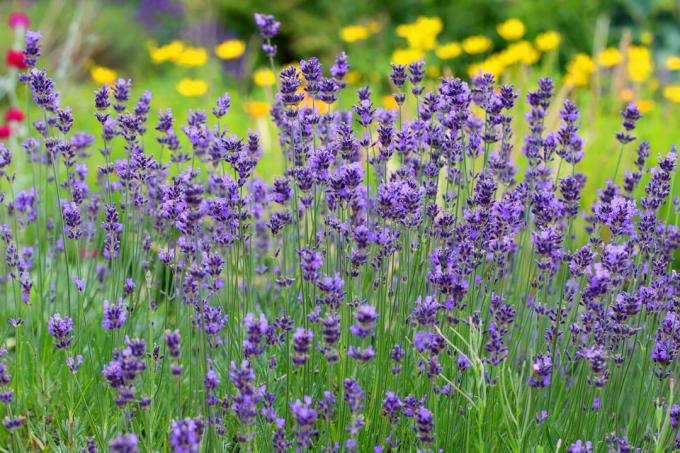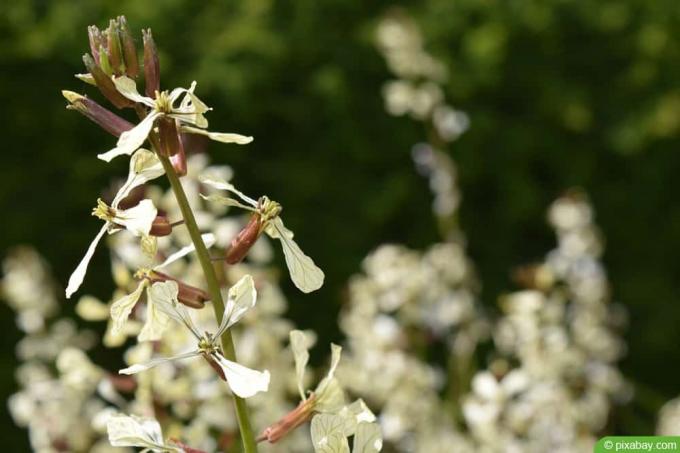

Table of contents
- Appropriate Varieties
- Location
- substrate
- prepare cultivation
- planting
- Plant neighbors and defense against pests
- mounting sequence
- Pour
- Fertilize
- harvest
- multiply
- Dill used as an aroma miracle
- Conclusion
Many only know dill from delicious dishes. The cucumber herb, as the dill is also called, can taste a lot more than just good. It deters a variety of pests, keeps the soil deeply loose and also looks decorative. What is not used in the kitchen after the harvest can therefore become part of a bouquet. The numerous advantages of growing dill in the garden are not accompanied by a high level of maintenance. On the contrary.
Appropriate Varieties
As a popular herb, dill is now available in numerous varieties. However, not all of them are suitable for outdoor cultivation. However, the following are recommended:
- Dill Tetra
- dill bouquet
- dill ducat
- Dill quadruplet
- Dill Hercules
Nevertheless, it must be noted that these dill varieties are only suitable for annual cultivation.
Location
If dill is to be planted successfully, the most important thing is the right location. Above all, this must be sunny and warm for the cucumber herb. It also does not harm the yield if the planting site is sheltered from the wind. Full sun is favourable, i.e. the south side. East and west can also be suitable if they are not additionally shaded and have at least three hours of sunlight.
In addition, when choosing the location, the space requirement should of course be taken into account. While most varieties of dill will only reach 8 to 12 inches in diameter, they can grow to 30 inches or more. This can be a problem, especially in small beds with dense cultivation and significantly lower but also sun-loving plants. The dimensions must therefore be taken into account when planning. Alternatively, choosing a rather compact and low dill variety, such as the potted dill delicate, is advisable. Although these are usually a bit more sensitive, they can also be planted in the garden.
substrate
Dill is quick and easy to please when it comes to choosing a substrate. Fresh garden soil, balcony soil or herbal soil can be used. In any case, it is important that the soil is loose and slightly calcareous. A substrate with an acidic pH value is therefore unfavourable.
Tip:
A simple test can be used to determine whether the bed is suitable for growing dill or not. Corresponding indicator strips can be found in stores.
prepare cultivation
Growing dill directly in a bed outdoors requires a bit of preparation. This is usually limited to loosening the soil by digging it up if necessary and, if necessary, adding some sand to improve water drainage. A small dose of well-rotted compost to enrich it with nutrients is also recommended. In terms of preparing the seeds, the effort is even less. These are simply rinsed off well with cool water before sowing. Pre-germination outside the bed, on the other hand, does not make sense. The reason for this can be found in the sensitivity of the dill plant. Even pricking out, i.e. removing the weakest germs in order to promote the growth of the stronger ones, is in many cases not tolerated or only badly tolerated by the cucumber herb.

The subsequent planting or transplanting of this plant is also usually associated with some losses. It is therefore better to sow directly in the bed and to avoid pre-germination.
planting
Growing dill is easy in itself. Nevertheless, when designing the bed and sowing, you should pay attention to the right approach and a few decisive factors. The following guide will help:
- The right time for sowing dill outdoors has come when frost is no longer to be expected and the temperatures are consistently at least 15 °C. As a rule, this does not have to be started before May or June.
- The bed is loosened up as described above and the soil mixed with sand and compost to create the ideal substrate.
- The seeds are soaked in cool water for a few minutes or rinsed thoroughly.
- Sow two to three seeds per spot. A distance of 20 to 30 centimeters must be maintained within the row. There should be 50 centimeters of space between the rows for easy cultivation and harvesting.
- The seeds are inserted about two centimeters deep or covered with an appropriate layer of soil.
- The soil is flooded with water so that the seeds can swell in the soil. However, waterlogging should be avoided.
It usually takes two to four weeks to germinate, but for this the outside temperature must be at least 15 and maximum 30 °C and the soil must be kept constantly moist. Emerging weeds must also be removed promptly, as these can initially become a threatening competitor to the dill.
Tip:
When the dill plants have reached a height of about ten centimetres, a layer of mulch should be applied to the bed. This prevents weeds from reappearing and keeps the soil moist for longer. The maintenance effort is thus reduced in two ways.
Plant neighbors and defense against pests
Dill gets along with almost every other plant. The exceptions are:
- Caraway seeds
- fenche
- cress
- basil
- potatoes
- sweetcorn
- lily family
Not only can dill be planted alongside a wide variety of other plants, it should be. The sweet yet spicy aroma of cucumber herb keeps numerous pests away. Below:
- Cabbage White
- carrot fly
- onion fly
- snails
A proximity to plants that are particularly endangered by these parasites therefore has a double benefit. The dill is best planted between other species.
Tip:
The dill itself is quite susceptible to aphids, from which it suffers quickly and severely and which can make large parts of the crop unusable. Planting lavender here and there among the dill can avoid such a threat.
mounting sequence
Dill is not only a bad neighbor to caraway and co., but also incompatible with itself. When growing dill, it should therefore be noted that the location must be changed every year. A break of two years per bed is usually sufficient.
Pour
Dill needs a lot of water and always slightly moist soil. However, it does not tolerate wet roots. Waterlogging should therefore never occur, but neither should dried-out substrate. As already mentioned, a layer of mulch reduces the watering effort considerably. In addition, the dill is also uncomplicated here, since both hard and soft water can be used for watering.
Tip:
Water with pond water every now and then – as long as it is free of chemical additives. This measure is also a light fertilization.
Fertilize
Fertilizing the dill is not necessary at all, but small doses of well-rotted compost can be given. Especially with several sowings per season, the additional supply of nutrients is recommended.
harvest
Dill is ready for harvest when it measures at least twenty centimeters. The young, fresh tips are cut off and used.
multiply
When the dill blooms and umbels form, all you have to do is wait for them to turn brown. At this point, the umbels can be cut off and the seeds removed from them. Stored dark, dry and cool, they survive the winter without any problems. In complete contrast to the dill plants, since these are annual and not frost hardy.
Dill used as an aroma miracle
- Your dill contains the most aroma when it is already in flower and you can harvest it after a few days of sunshine.
- If you want to add dill to cooked dishes, then it is added at the very end, so that its succinct but delicate aroma does not suffer from long cooking.
- An excess of fresh dill can also be very well preserved in oil, or you can mix it in a strong dill butter that you can enjoy over the next few days as a “herbal cure on bread and butter”.
- You can use too much dill to pickle a salmon (or a salmon trout or a tuna or another firm-fleshed fish), in the classic graved salmon recipe, dill is one of the main ingredients.
Conclusion
Growing dill in the garden is very easy and has several advantages. Defense against pests, optics and culinary enrichment are quick and easy with the dill Plants to achieve - so the spicy herb is also ideal for all newcomers to the plant culture.
 garden editorial
garden editorial I write about everything that interests me in my garden.
Learn more about garden herbs

Lady's mantle: 9 tips for planting, caring for and cutting
The lady's mantle can be found in almost every garden. There are around 1,000 different species. Here's the best time to plant it and how to care for it. it is also clarified whether and how it has to be cut.

Lavender, Lavandula angustifolia: 14 tips of care
Compared to other lavender varieties, Lavandula angustifolia is hardy down to temperatures of -15°C. In addition, he does not place very high demands on the location. It only needs to be sunny and sheltered from the wind and it loves lean, well-drained and calcareous soil.

Rosemary leaves have white spots: what to do?
Rosemary can be affected by white spots all year round. Before using home remedies, the problem should be investigated. If site conditions and care measures are optimal, diseases and pests can be the cause. Fungi require different control measures than harmful insects.

Rocket is blooming: is it still edible when blooming?
Rocket, also known as rocket, is a traditional cultivated plant that has been somewhat forgotten in recent years. It is now back in fashion and can be found in numerous dishes as a raw vegetable salad, side dish or herb.

Make your own mint tea – What is the effect of fresh mint tea?
Mint tea tastes best when you brew it from freshly picked mint leaves. In this way, the aromatic herb unfolds its healing effect against all kinds of ailments. However, there are also contraindications, because fresh mint tea can also have undesirable side effects.

Harvest peppermint when it blooms? | What to watch out for with mint
Due to its spicy flavor and easy-care properties, peppermint has become widespread in the local latitudes. Only the leaves need to be harvested for consumption. However, there are a number of factors to consider during the flowering period, as the flavor then changes significantly.
